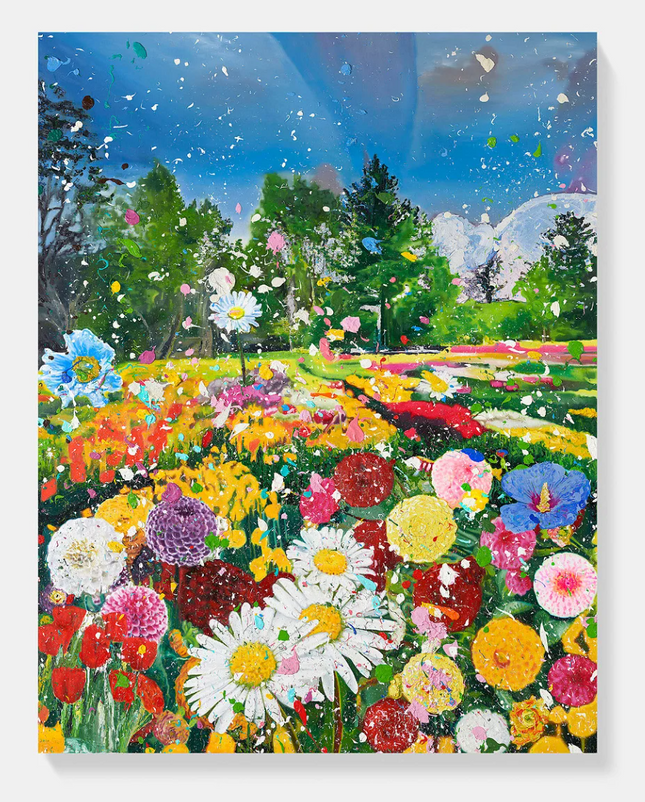
Flowers & Plants
-

Damien Hirst Selflessness H14-7 The Secret Gardens Aluminum Giclee by Damien Hirst
Selflessness H14-7 The Secret Gardens Pop Street Artwork Limited Edition Giclee Print on Aluminum Sheet by Urban Graffiti Modern Artist Damien Hirst. 2024 Signed & Numbered In Verso on Label Limited Edition of 578 Artwork Size 36.61x47.24 Laminated Giclee Metal Print on Aluminum Sheet Part of the Collection: The Secret Gardens Paintings. The Fusion of Urban Aesthetics and Natural Imagery Selflessness H14-7, a captivating piece within 'The Secret Gardens' series by the prominent English artist Damien Hirst, is a mesmerizing confluence of street pop art and graffiti artwork. This limited edition giclee print on an aluminum sheet represents a bold step in Hirst's oeuvre, amalgamating the raw vitality of street art with the meticulous sophistication of fine art printmaking. This piece, signed and numbered by the artist in verso on a label, underscores his adeptness not only in traditional artistic realms but also in the innovative domain of urban art. With only 578 editions available, the artwork, measuring 36.61x47.24 inches, emerges as a covetable collectible. Hirst, born in Bristol, England, in 1965, continues to be a towering figure in the art world, known for his audacious and often controversial works that explore themes of life, death, and experience. His journey into street pop art and graffiti artwork with this collection offers a fascinating lens through which to view his unceasing evolution as an artist. Eclectic Aesthetics of Street Pop Art and Graffiti Artwork 'Selflessness H14-7' integrates street pop art's spontaneity and rebellious spirit with the elegance of Hirst's more traditional art forms. The giclee metal print technique, known for its high fidelity to the original color palette and precision, provides a durable and reflective quality that is both modern and luxurious. In this work, Hirst harnesses the aluminum's inherent properties to imbue the image with a dynamic sheen, further intensifying the visual impact of the floral array depicted. The piece's vibrant composition is a vivid flora tableau that seems to burst forth from the confines of its metallic canvas. The artwork is reminiscent of the brief and organic graffiti tags in urban landscapes, transforming into a permanent and prestigious form. Hirst's signature use of vibrant colors and the layering of paint drops create a sense of depth and texture often associated with graffiti art. Damien Hirst and the Allure of Aluminum Prints In 'The Secret Gardens series, Hirst continues to challenge the boundaries between high art and the more democratic and streetwise expressions of pop and graffiti art. By presenting this series as laminated giclee prints on aluminum sheets, Hirst is not only indulging in the aesthetic pleasure of reflective mediums but also underscoring the permanence of art in contrast to the often transient nature of street art. The metal substrate connotes an industrial backdrop reminiscent of the urban environments that birth graffiti, providing a poignant canvas for nature's lush and chaotic depictions. This choice of medium and technique marks a deliberate fusion of the fleeting with the everlasting, the organic with the manufactured, and the traditional with the avant-garde. 'Selflessness H14-7' thus becomes an artifact of modern urban culture, elevated to high art through Hirst's deft conceptualization and execution. The artwork reflects Hirst's perpetual exploration of life's dualities and the complexities of human perception. It speaks to the viewer on multiple levels, inviting them to reconsider the conventional divisions between art forms and the spaces they occupy. Damien Hirst's 'Selflessness H14-7' from 'The Secret Gardens series significantly contributes to street pop art and graffiti artwork. Using an aluminum sheet as a canvas for a giclee print showcases the hybridization of art forms. It mirrors the synthesis of urban grit with the vibrancy of the natural world. As Hirst continues to produce thought-provoking art actively, works like this not only captivate the imagination of their audience but also hold a mirror to the evolving landscape of contemporary art itself.
$7,876.00


